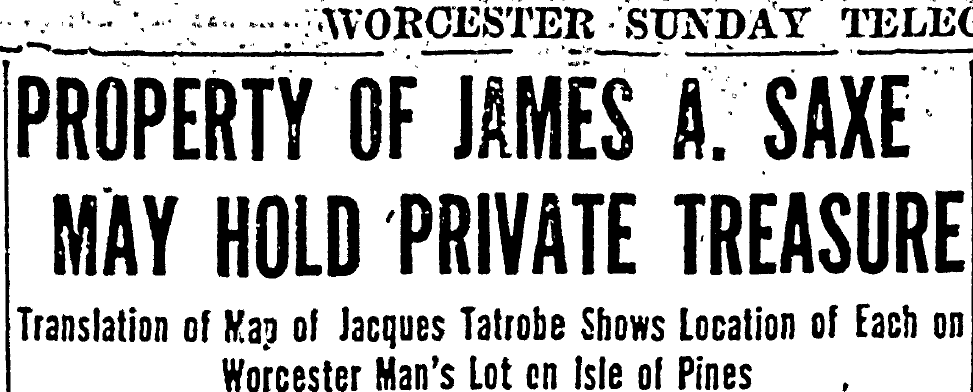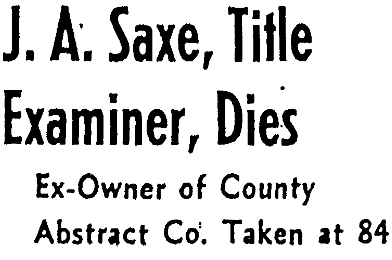You may be aware of our two main meeting spaces, the Saxe Room and the Banx Room, but do you know how they got their names? Today's blog post is going to focus on the origins of the larger meeting room, the Saxe Room, named after James Alfred Saxe and his wife, Mary Wick Saxe.
 |
| "Succumbs," Worcester Telegram, May 20, 1948 |
So who were the Saxes and why are their names immortalized at our library?
James Alfred Saxe, was born in Troy, NY, on December 2, 1863 and lived in Massachusetts most of his life. James, the twin brother of John W. Saxe and nephew of poet James Godfrey Saxe, was educated at Wilbraham Academy, Wesleyan College, and Harvard College. He also studied singing and violin at the Berlin Conservatory of Music before returning to the United States to study law at Harvard Law School. He graduated law school in 1892 and married Mary Wick of Cleveland, Ohio, the daughter of a banker, in June of that same year. James worked for a couple of years with his brother in Boston before James and Mary moved to Worcester in 1895, where he became a title examiner at the metropolitan water board. He founded the Worcester County Abstract Co. in 1897 [Note: a title examiner is a person who researches the history and previous owners of a specific piece of property], where he remained active in the company until 1929.
 |
| Undated Photo of James A. Saxe |
James was an prominent member of the Worcester community, with news reports through the years detailing his performances as a bass singer in church quartets and other concerts, his memberships in the Church of the Unity/First Unitarian Church and the Worcester County Bar Association, his participation in golf tournaments, and his donation of a rare coin collection to the Worcester Historical Society.
 |
| Mary Wick Saxe's Photo on Her Emergency Passport Application, circa April 1920 |
Mary Wick Saxe was a frequent world traveler (many times accompanied by her mother, also named Mary, and sometimes her husband, James- the three of them even took a 9-month voyage around the world in 1907!), and would recount her grand adventures at gatherings of the Worcester Woman's Clubhouse Association and in the Worcester newspapers. She once wrote about her experiences in India in the
Worcester Evening Gazette in 1914. By the late-1910s, James and Mary owned an estate in the American settlement of Vivi Agua (also known as Bibijagua), Isle of Pines, Cuba, that served as their winter home. There were even rumors of buried pirate treasure on the property but no troves were ever reported to have been found.
 |
"Property of James A. Saxe May Hold Private Treasure." Worcester Sunday Telegram, May 18, 1919
|
 |
| "Saxe's Bungalow in Isle of Pines," 1933 |
Mary died in 1939 at the age of 71 in Cuba after a long illness. She was buried in Cuba at the Columbia Cemetery.
 |
| Report of the Death of an American Citizen - "Mary Wicks [sic] Tennis Saxe" May 12, 1939 |
James Alfred Saxe died May 19, 1948 at the age of 84 in his home on 227 Burncoat Street in Worcester. He was buried in Oakwood Cemetery in Troy, NY.
 |
| J.A. Saxe, Title Examiner, Dies." Worcester Telegram, May 20, 1948 |
A week after Saxe died, the Worcester newspapers reported on the contents of Saxe's will. One major bequest was $50,000 to the City for the Worcester Public Library. At that time, it was the largest gift to the library and adjusted for inflation, $50,000 in 1948 currency would be worth over $650,000 today! Per the will, twenty-five thousand dollars would be used to create a James A. and Mary W. Saxe Room at the new public library, if and when it was erected (if you recall from previous blog posts, the new library building at 3 Salem Square would not be completed until 1964). The other half of the bequest for the library was to be used to purchase "books of a serious nature for the present library" (Worcester Evening Gazette, May 24, 1948). The will stipulated that if the new public library was not built within 21 years, the money could be used to purchase additional books for the library. The Saxe Fund was to be left in the hands of private trustees and then it would be turned over to the city.
 |
| "$50,000 is Left City in Saxe Bequests," Worcester Evening Gazette, May 24, 1948, p.1 |
By 1953, part of the Saxe Fund was used to acquire poetry records, music scores, and projection equipment and screens to show documentary films and slide-film programs. Trustees of the Saxe Fund also created a scholarship fund in 1955 for present and prospective staff to study library science. The Saxe Fund is still in existence.
 |
| The Saxe Collection of Recorded Poetry Drama and Speech, 1953 |
In 1962, the library board asked the trustees of the Saxe estate to contribute the funds for two meeting rooms "in accordance with the provisions of the Saxe will" (Worcester Evening Gazette, November 14, 1962). In May 1964, the new library building at 3 Salem Square finally opened to the public, with the Saxe Room and Conference Room A located on the second floor of the library. Both rooms were designed in the fashion of the 1960s, with walls in teak and drapes in wildly clashing colors, called "Joseph's Coat." The Saxe Room would fit 135 people and Conference Room A would fit 40 people. The Saxe Room was intended to be used for film screenings and recitals, among other meetings.
 |
| "I'm Confident Our Readers Will Like It," Worcester Sunday Telegram - Feature Parade Section, March 1, 1964 |
Conference Room A would become the Al Banx Room in 1974. Renovation of the Saxe and Banx Rooms began in the summer of 1988. It included new ceilings, carpet, paneling, furniture, and most importantly, asbestos abatement. The Saxe and Banx Rooms were rededicated in October 1988.
The Saxe and Banx Rooms moved to their present location on the first floor by the parking lot entrance during the major library renovation that finished in 2001. The two rooms are still in use today for library programs and community meetings. So when you attend one of our library programs in the Saxe Room, you can surprise everyone with your knowledge of the history of the space!
Stay tuned for a future blog post on the Banx Room...
Sources:
"Announce Fund for Library Scholarships." (1955, March 3). Worcester Evening Gazette, 8.
"Banx, Saxe Rooms Rededicated." (1988, October 23). Worcester Sunday Telegram, 35 A.
"50,000 is Left City in Saxe Bequests." (1948, May 24). Worcester Evening Gazette, 1.
"I'm Confident Our Readers Will Like It." (1964, March 1). Worcester Sunday Telegram - Feature Parade Section, 14.
"J.A. Saxe, Title Examiner, Dies." (1948, May 20). Worcester Telegram, 1.
"James A. Saxe, 84, Dies in His Home." (1948, May 20). Worcester Evening Gazette, 60.
"Library Anticipates $1,800 Budget Hike." (1962, November 14). Worcester Telegram, 18.
"Library Tour A Colorful Experience." (1964, April 21). Worcester Telegram, 13.
"Mrs. James A. Wick Saxe." (1939, May 13). Worcester Telegram, 4.
"$100,000 Charity Bequests in James A. Saxe's Will." (1948, May 25, 1948). Worcester Telegram, 11.
"Postal Rate Rise Hits Library Budget. (1962, November 14). Worcester Evening Gazette, 6.
"Property of James A. Saxe May Hold Private Treasure." (1919, May 18). Worcester Sunday Telegram, 12C.
"Rare Old Coins Given Society." (1945, July 5). Worcester Telegram, 2.
"Saxe Tours the World." (1907, August 2). Worcester Telegram, 14.
"Work, Real Hard Work." (1900, July 1). Worcester Sunday Telegram, 9.
The Worcester Free Public Library. (1953).
The Saxe Collection of Recorded Poetry Drama and Speech.
 The Gunfighters: How Texas Made the West Wild by Bryan Burrough. Burrough (coauthor of Forget the Alamo: The Rise and Fall of an American Myth) offers a captivating exploration of the Wild West, delving into the era of gunfighters with literary flair and historical depth. He makes the case that Texas was the locus of gun violence in the 19th century (with the highest murder rate per capita in U.S. history), particularly due to its hostile borders with Comanche territory and with Mexico, the coexistence there of Confederate and Union supporters, and the surging cattle business, which was often accompanied by rustlers, gamblers, and vigilantes. However, Burrough also argues that the violent reality of Texas was inflated by sensationalistic journalism, creating a morass of myths and facts. While focusing on activities in and around Texas, Burrough's book is also a more nuanced portrayal of figures such as Wild Bill Hickok, Billy the Kid, and Wyatt Earp than often appears in popular history accounts. The book is fascinating and will be widely popular due to its subject matter, plus it offers two 16-page sets of photos and illustrations and six helpful maps. A must-read for anyone interested in understanding the enduring legacy of the Wild West, in which Burrough expertly separates fact from folklore. VERDICT A fascinating work of history that challenges readers to reconsider the role of the West's legendary gunfighters in shaping the identity of the United States. Copyright 2025 LJ Express.
The Gunfighters: How Texas Made the West Wild by Bryan Burrough. Burrough (coauthor of Forget the Alamo: The Rise and Fall of an American Myth) offers a captivating exploration of the Wild West, delving into the era of gunfighters with literary flair and historical depth. He makes the case that Texas was the locus of gun violence in the 19th century (with the highest murder rate per capita in U.S. history), particularly due to its hostile borders with Comanche territory and with Mexico, the coexistence there of Confederate and Union supporters, and the surging cattle business, which was often accompanied by rustlers, gamblers, and vigilantes. However, Burrough also argues that the violent reality of Texas was inflated by sensationalistic journalism, creating a morass of myths and facts. While focusing on activities in and around Texas, Burrough's book is also a more nuanced portrayal of figures such as Wild Bill Hickok, Billy the Kid, and Wyatt Earp than often appears in popular history accounts. The book is fascinating and will be widely popular due to its subject matter, plus it offers two 16-page sets of photos and illustrations and six helpful maps. A must-read for anyone interested in understanding the enduring legacy of the Wild West, in which Burrough expertly separates fact from folklore. VERDICT A fascinating work of history that challenges readers to reconsider the role of the West's legendary gunfighters in shaping the identity of the United States. Copyright 2025 LJ Express.
















